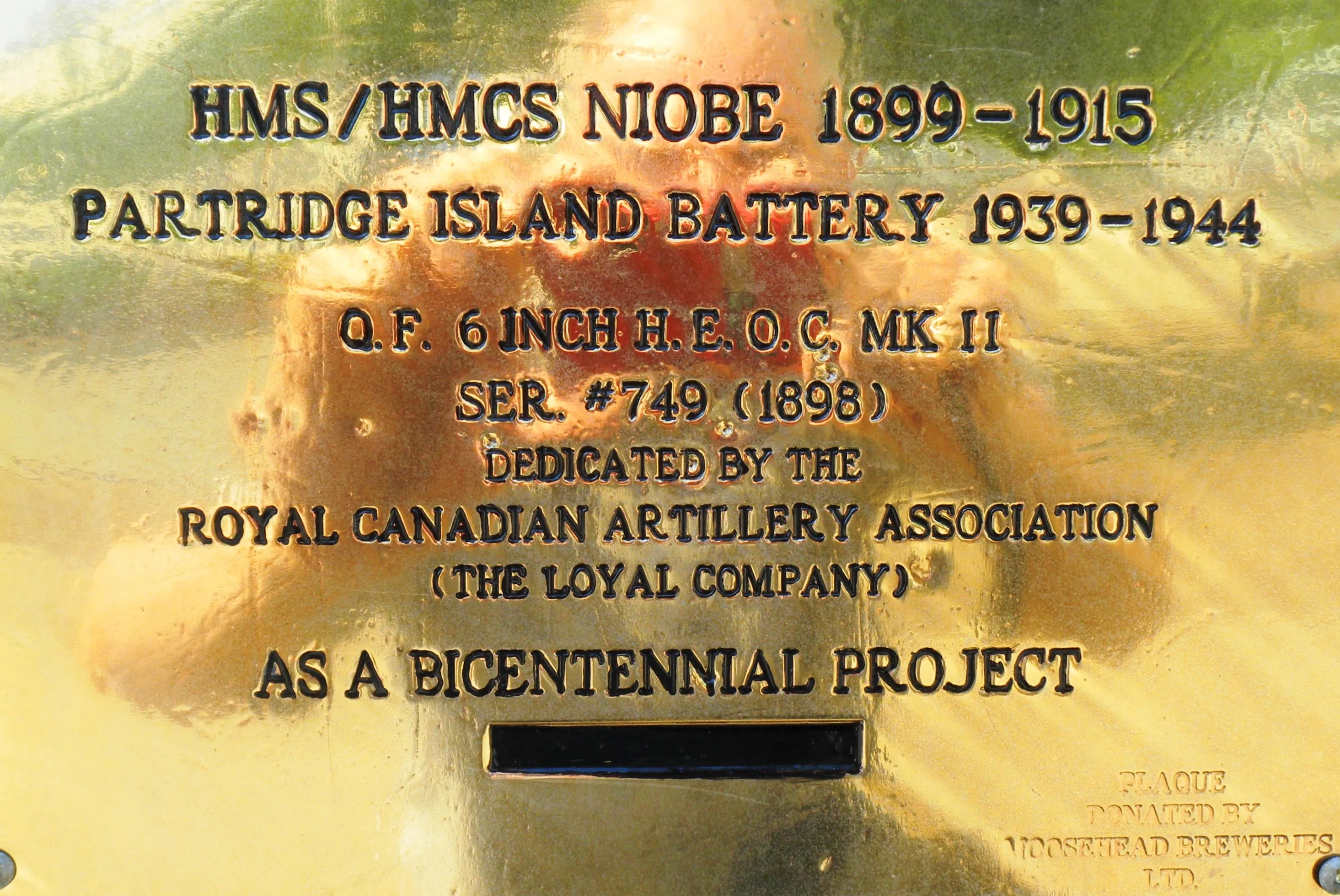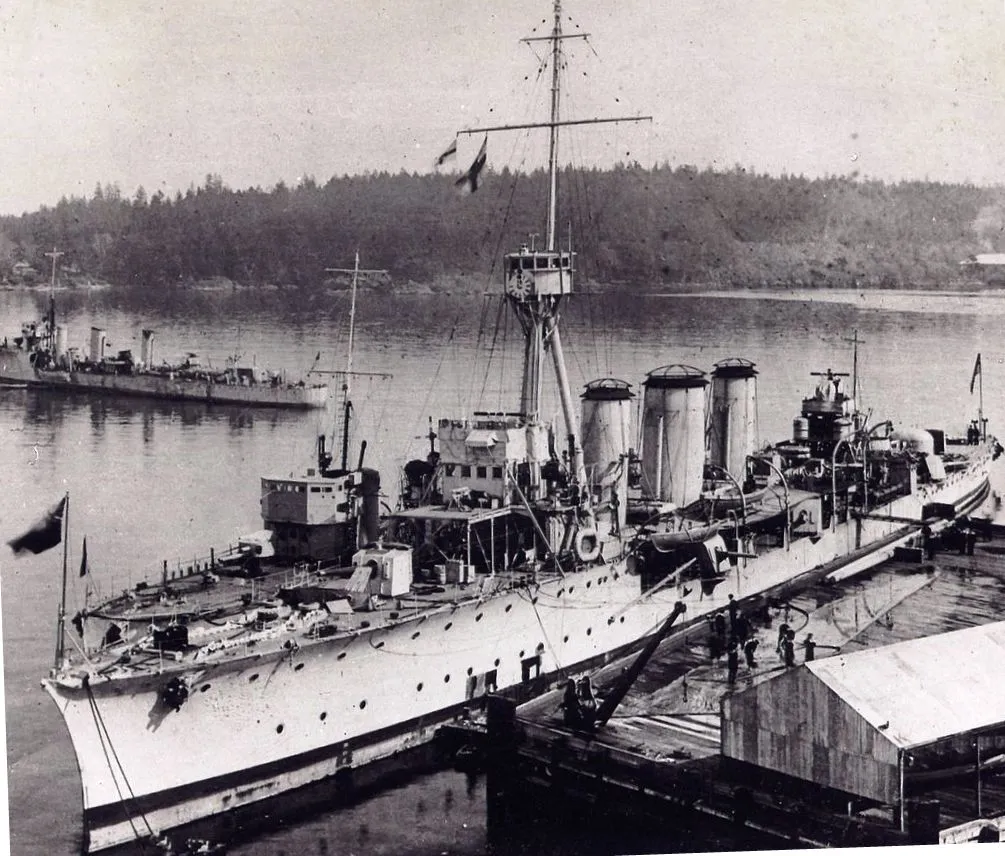Royal Canadian Navy Cruisers, HMCS Rainbow, HMCS Niobe, HMCS Aurora; Destroyers: HMCS Patrician, HMCS Patriot, HMCS Champlain, and HMCS Vancouver
Royal Canadian Navy (RCN) 1910–1939, Cruisers and Destroyers
Founding of the Naval Service of Canada (1910), and the formation of the Royal Canadian Navy (1911)
The Naval Service of Canada (NSC) was established following the introduction of the Naval Service Act by Prime Minister Sir Wilfred Laurier. It was intended that it should be a distinct naval force for Canada, and that, should the need arise, it could be placed under British control. The bill received royal assent on 4 May 1910. The NSC was initially equipped with two former Royal Navy (RN) vessels, HMCS Niobe and HMCS Rainbow. King George V granted permission for the service to be known as the Royal Canadian Navy on 29 August 1911.
During the first years of the First World War, the RCN was equipped with six ships which patrolled both the North American East and West coasts to deter the German naval threat. A seventh ship, HMCS Shearwater, joined the force in 1915. Just before the end of the war in 1918, the Royal Canadian Naval Air Service (RCNAS) was established with the purpose of carrying out anti-submarine operations. The RCNAS was disbanded after the armistice of 11 November 1918.
After the war, the Royal Canadian Navy took over certain responsibilities of the Department of Transport's Marine Service, and slowly started to build its fleet, with the first warships specifically designed for the RCN being commissioned in 1932.
Cruisers
HMCS Rainbow (the RCN’s first ship, Apollo class); HMCS Niobe (the RCN’s second ship, Diadem class); HMCS Aurora (Arethusa class)

(Vancouver Public Library Historical Photographs, VPL 3132)
HMCS Rainbow Rainbow in Vancouver harbour, 1914. HMCS Rainbow, formerly HMS Rainbow, was an Apollo-class protected cruiser built for Britain's Royal Navy by Palmers at Hebburn-On-Tyne in England. She was launched on 25 March 1891 as HMS Rainbow and entered service in 1893. She was transferred to the Royal Canadian Navy in 1910. During the First World War, HMCS Rainbow was the only major Commonwealth warship on the western coast of North America at the outbreak of war. She patrolled the Pacific coast as far south as Panama. In 1916 and early 1917, she transported $140 million in Russian bullion between Esquimalt and Vancouver. This money was placed in trust with Canada by the Russian government for protection due to the impending Russian revolution. She was paid off on 8 May 1917. On 5 July 1917 she was recommissioned to serve as a depot ship at Esquimalt. She was paid off again on 1 June 1920 and scrapped.

(City of Vancouver Archives Photo, AM54-S4-: Mil P290.09)
HMCS Rainbow, with a civilian examining one of her QF 12-pounder 12-cwt guns. These were a versatile 3-inch (76.2 mm) calibre naval gun introduced in 1894. It was produced by Armstrong Whitworth, Elswick and used on Royal Navy warships, exported to allied countries, and and also used for land service. In British service "12-pounder" was the rounded value of the projectile weight, and "12 cwt (hundredweight)" was the weight of the barrel and breech, to differentiate it from other "12-pounder" guns. 20 July 1914.
HMCS Rainbow, the first warship purchased for the Naval Service of Canada. She was 100 metres long, displaced 3,400 tons, and could maintain a speed of 20 knots. She was armed with two 6-inch/40 Mk. II QF gun. These 5-ton bow and stern chaser guns were mounted singly on the fo’c’sle and quarterdeck, six 4.7-inch/40 QF guns (produced by Elswick) firing a 45-lb shell and mounted broadside, eight 6-pounders, one 3-pounder, and four 14-inch torpedo tubes. She also carried one 12-pounder 8-cwt QF Naval Landing Gun and four .303-inch Maxim Machine Gun. Mark Tunnicliffe. Also Macpherson, Ken; Barrie, Ron. The Ships of Canada's Naval Forces 1910–2002 (Third ed.). (Vanwell Publishing, St. Catharines, Ontario, 2002).

(RCN Photo)
HMCS Rainbow in 1910.

(RCN Photo)
HMCS Rainbow in 1910.

(City of Vancouver Archives Photo)
HMCS Rainbow, Vancouver, ca 1912.

(City of Vancouver Archives and RCN Photo)
HMCS Rainbow, Aug 1910.

(City of Vancouver Archives and RCN Photo)
HMCS Rainbow, Aug 1910.

(City of Vancouver Archives and RCN Photo)
HMCS Rainbow, Aug 1910.
HMCS Niobe

(RCN Photo)
HMCS Niobe ca. 1910, Royal Canadian Navy. HMS Niobe was a ship of the Diadem-class of protected cruiser in the Royal Navy. She served in the Boer War and was then given to Canada as the first ship of the then newly created Royal Canadian Navy as HMCS Niobe. After patrol duties at the beginning of the First World War, she became a depot ship in Halifax. Damaged in the 1917 Halifax Explosion, she was scrapped in the 1920s. Two of HMCS Niobe's 6-inch guns are preserved in the City of Saint John, New Brunswick.

(RN Photos)
HMS Niobe in 1897 before being transferred to the RCN as HMCS Niobe in 1910.

(CFB Esquimalt Museum Photo)
HMCS Niobe on her arrival at Halifax, 21 Oct 1910.

(RCN Photo)
HMCS Niobe on her arrival at Halifax, 21 Oct 1910.

(RCN Photo)
HMCS Niobe.

(A MacLauglan Photo)
HMCS Niobe, Halifax.

(Library and Archives Canada Photo, MIKAN No. 3332976)
HMS Niobe in drydock in Halifax, 1917.

(Library and Archives Canada Photo, PA-139151)
HMCS Niobe quarterdeck, 6-inch guns.

(Author Photo)

(Author Photo)

(Author Photo)
HMCS Niobe 6-inch QF Gun, HBOC Mk. II, Serial No. 749, 1898, on display at HMCS Brunswicker, Saint John, New Brunswick.

(Author Photo)

(Author Photo)
HMCS Niobe 6-inch QF Gun, 3 Field Regiment, Saint John, New Brunswick.

(Library and Archives Canada Photo, MIKAN No. 4046357)
HMCS Niobe stamp issued in 2010.
HMCS Aurora

(Library and Archives Canada Photo, MIKAN No. 3400003)
HMCS Aurora, Esquimalt, British Columbia, 1921. HMS Aurora, one of eight Arethusa-class light cruisers, was launched on 30 September 1913 at Devonport Dockyard. She had served with the Grand Fleet from 1914 to 1916. The RCN took possession of HMS Aurora on 1 November 1920 and renamed her HMCS Aurora. She was decommissioned in 1922 and scrapped in 1927.

(RCN Photo)
HMCS Aurora, ca 1921.

(Colin Stevens Photo)
4-inch/45 QF Mk. IV Gun, on a single mount, (Serial No. 985), from HMCS Aurora. This naval gun is located in front of the Merchant Navy, Army, Navy & Air Force (ANAF) Hall, 9831 4th Street, Sidney, British Columbia.

(Author Photo)

(Author Photo)
Destroyers
HMCS Patrician (Thornycroft “M” class); HMCS Patriot (Thornycroft “M” class); HMCS Champlain (Admiralty “S” class); HMCS Vancouver (F6A) (Admiralty “S” class).
HMCS Patrician and HMCS Patriot came to Canada in 1920, along with the cruiser HMCS Aurora as replacements for HMCS Rainbow and HMCS Niobe. HMCS Patrician served on the West Coast, while HMCS Patriot served on the East coast, both as training ships. Both were sold for scrap in 1929.
HMCS Patrician

(Library and Archives Canada Photo, MIKAN No. 3724011)
HMCS Patrician (Thornycroft “M” class). HMCS Patrician and HMCS Patriot were commissioned in 1916,and served in the RN for the duration of the First World War. In 1920 HMCS Patrician, HMCS Patriot, and the cruiser HMCS Aurora were offered to Canada as replacements for the decrepit HMCS Niobe and HMCS Rainbow. The three were commissioned at Devonport on 1 Nov 1920, and left for Canada a month later. When the naval budget was cut by a million dollars in 1922, the two destroyers became the only seagoing ships in the RCN. HMCS Patrician was ordered that autumn to the west coast, where she was to spend the next five years training officers and men of the naval reserve. As perhaps the strangest assignment of her career, HMCS Patrician was detailed in Nov 1924, to intercept a band of Nanaimo bank-robbers trying to reach the United States by motor launch. HMCS Patrician was sold for scrap in 1929 to a Seattle company to be broken up.

(IWM Photo SP1654)
HMCS Patrician, shown here when it was HMS Patrician (G56) in RN service in 1916.
HMCS Patriot

(Library and Archives Canada Photo, MIKAN No. 3724024)
HMCS Patriot (Thornycroft “M” class). HMCS Patrician was commissioned in 1916, and served in the RN for the duration of the First World War. In 1920 HMCS Patrician was offered to Canada and commissioned at Devonport on 1 Nov 1920, leaving for Canada a month later. HMCS Patriot was stationed at Halifax where she spent the next five years training officers and men of the naval reserve. In Sep 1921, she assisted Dr. Alexander Graham Bell, towing his experimental hydrofoil craft HD-4 at high speed on Bras d'Or Lake near Baddeck, NS. HMCS Patriot was sold for scrap in 1929 and broken up at Briton Ferry, Wales.

(RCN Photo MC-10024)
HMCS Patriot (Thornycroft “M” class).
HMCS Champlain

(IWM Photo, KMD-03502)
HMCS Champlain, ca. 1932. Initially named HMS Torbay, she was commissioned in the RN in 1919. She was lent to the RCN while replacements for HMCS Patrician and HMCS Patriot were being built in Britain. The transfer took place at Portsmouth on 1 Mar 1928. In May 1928, HMCS Champlain arrived at Halifax to provide reserve training. 5 Jan 1935, HMCS Skeena and HMCS Vancouver departed Esquimalt for exercises in the Kingston, Jamaica area with HMCS Champlain and HMCS Saguenay. She was paid off on 25 Nov 1936 and sold for scrap in 1937.
HMCS Vancouver

(IWM Photo, IKMD-04359)
HMCS Vancouver. Initially named HMS Toreador, HMS Vancouver was originally commissioned in the RN in 1919. She was loaned to the RCN while replacements were being built for HMCS Patrician and HMCS Patriot. She was transferred to the RCN on 1 Mar 1928. In May 1928, she arrived in Esquimalt to provide reserve training. On 24 Jan 1932 HMCS Skeena and HMCS Vancouver provided protection to British assets and civilians in El Salvador at the request of the British Consul in San Salvador following the outbreak of a peasant uprising. A landing party was briefly sent ashore at Acajutla, but the situation there improved and the sailors saw no combat, although the two ships remained in the area until the end of the month. On 5 Jan 1935, HMCS Skeena and HMCS Vancouver departed Esquimalt for exercises in the Kingston, Jamaica area with HMCS Champlain and HMCS Saguenay. She was paid off on 25 Nov 1936 and sold for scrap in 1937.

(Library and Archives Canada Photo, MIKAN No. 3400265)
HMCS Vancouver, Prince Rupert, British Columbia, July 1928.
Esquimalt

(Library and Archives Canada Photo, MIKAN No. 3336440)
Warships in Esquimalt Harbour, British Columbia, early 1900s.

